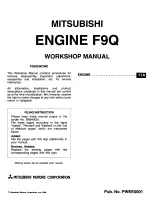
22
109821_0508
(5) Starter and Alternator Servicing
Service the starter and alternator every 1000 hours of oper-
ation. Do the following:
1. Starter commutator cleaning
2. Alternator slip ring cleaning
3. Carbon brushes and the brush contact check
(6) Radiator Pressurization Valve Check
A pressurization valve is incorporated in the radiator cap
assembly. Check the valve actuating pressure with a radiator
pressure tester. For the pressurization valve actuating pres-
sure and the check interval, follow the equipment manufac-
turer's standards.
8. Engine Care During Cold Season
8.1 Fuel
(1) Fuel Selection
In the cold zone, the fuel may gel resulting in hard engine
starting; therefore, select a suitable fuel for these conditions.
Use ASTM 975 No. 2-D fuel if you expect temperature
above - 7°C (20°F).
Use Number 1-D if you expect temperatures below - 7°C
(20°F).
If Number 1-D is not available, a "winterized" blend of 1-
D and 2-D is available in some areas during the winter
months.
Check with the service station operator to be sure you get
the properly blended fuel.
8.2 Coolant
Where the atmospheric temperature falls below freezing
point, the cooling system should be drained after engine oper-
ation, but to eliminate the need for repeated draining and
refilling, the use of anti-freeze solution is highly recom-
mended.
A 50/50 Ethylene glycol base antifreeze/water mix.
(which provides protection to -37°C (-34°F) is recom-
mended for use in these Shibaura diesel engines).
Concentrations over 65% adversely affect freeze protec-
tion, heat transfer rates, and silicate stability which may cause
water pump leakage.
Never exceed a 60/40 antifreeze/water mix.
(which provides protection to about -50°C (-58°F).
WARNING:
Under some conditions the ethylene
glycol in the engine coolant is combustible. To
help avoid being burned when adding engine cool-
ant, do not spill it on the exhaust system or engine
parts that may be hot. If there is any question,
have this service performed by a qualified techni-
cian.
CAUTION:
1. Methyl alcohol base antifreeze is not recom-
mended because of its effect on the non-metallic
components of the cooling system and because of
its low boiling point.
2. High silicate antifreeze is not recommended
because it could cause serious silica gelation prob-
lems.
3. Usage and mixing ratio etc. should be followed
to the antifreeze manufacture's recommendations.
8.3 Engine Oil
Engine oil viscosity largely affects engine startability, so
the use of lubricant with selected viscosity according to the
atmospheric temperature is important. (Refer to page 9)
At low atmospheric temperature, engine oil viscosity will
increase to cause hard engine starting.
8.4 Battery
1. Make sure batteries are completely charged during cold
weather.
As the discharge current from the battery is more
demanding in cold engine starting, it takes a compara-
tively longer time to recharge the batteries than tit would
after normal engine starting.
An insufficiently charged battery is more susceptible to
freezing.
Pay attention to keep the battery charged during the cold
season
2. Check and fill the battery with distilled water before
engine operation.
If done after the engine has already been in an operation,
the distilled water will not mix with the original electro-
lyte, allowing the danger of freezing distilled water
remaining in the upper part of the battery cell.
8.5 Engine Starting
When starting the engine, with temperatures of below 0°C
(32°F), following these procedures:
1. Do the preheating operation before cranking the engine
with the starter.
2. Set the engine throttle lever or pedal to the 1/3 position of
the full lever or pedal stroke.
3. If the engine does not start with the initial cranking, wait
a while to allow the batteries to recover their power and,
reattempt the preheating and the cranking operation.
4. In order to protect the starter, cranking time must be lim-
ited to 10 seconds.
5. Rapid and repeated engaging and disengaging of the
starter gear with the flywheel ring gear during an attempt
to start the engine indicates a low battery charge. Discon-
nect the battery and charge it.
6. In extreme cold temperature engine starting, crank the
engine with the throttle closed and no preheat to prelube
the engine (initial engine oil flow). Then open the throttle
to 1/3 position and preheat to start.
CAUTION:
Do not use starting "aids" in the air
intake system. Such aids can cause immediate
engine damage.
Содержание E673L
Страница 2: ...2 109821_0508...









































